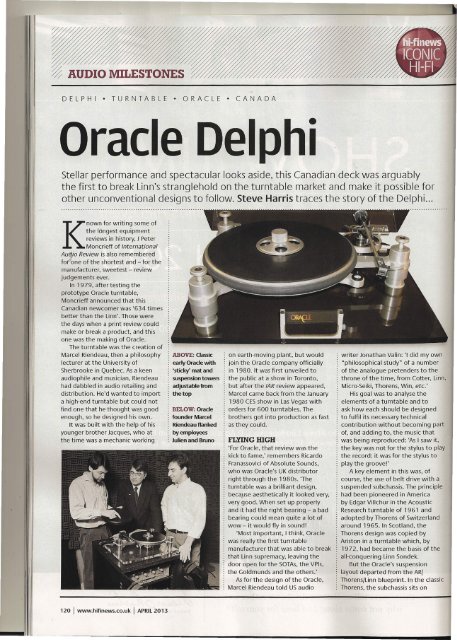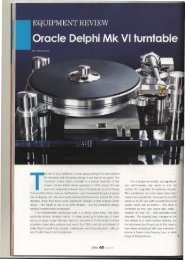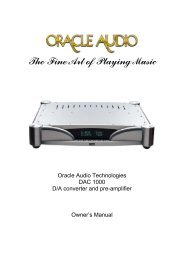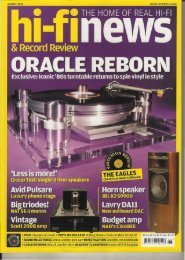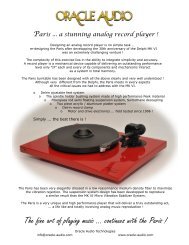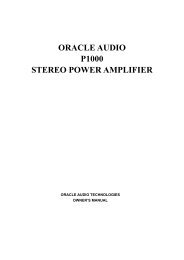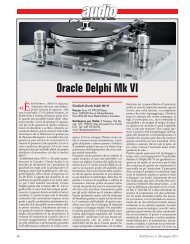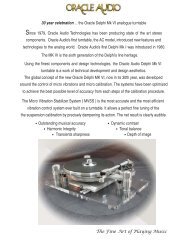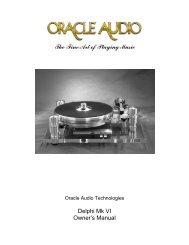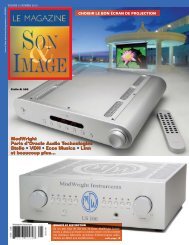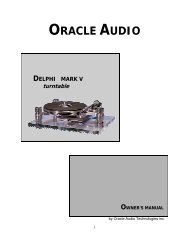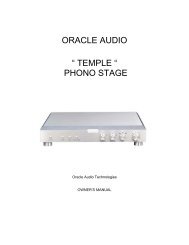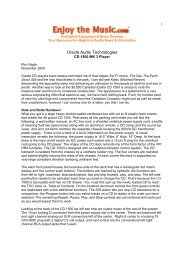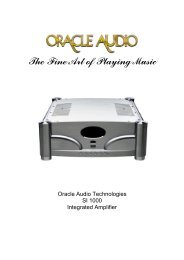Oracle Delphi
Oracle Delphi
Oracle Delphi
Create successful ePaper yourself
Turn your PDF publications into a flip-book with our unique Google optimized e-Paper software.
% AUDIO MILESTONES<br />
DELPHI' TURNTABLE' ORACLE' CANADA<br />
<strong>Oracle</strong> <strong>Delphi</strong><br />
Stellar performance and spectacular looks aside, this Canadian deck was arguably<br />
the first to break Linn's stranglehold on the turntable market and make it possible for<br />
other unconventional designs to follow. Steve Harris traces the story of the <strong>Delphi</strong> ...<br />
Known for writing some of<br />
the longest equipment<br />
reviews in history, J Peter<br />
Moncrieff of International<br />
Aul(io Review is also remembered<br />
for one of the shortest and - for the<br />
manufacturer, sweetest - review<br />
judgements ever.<br />
In 1979, after testing the<br />
prototype <strong>Oracle</strong> turntable,<br />
Moncrieff announced that this<br />
Canadian newcomer was '634 times<br />
better than the Linn'. Those were<br />
the days when a print review could<br />
make or break a product, and this<br />
one was the making of <strong>Oracle</strong>.<br />
The turntable was the creation of<br />
Marcel Riendeau, then a philosophy<br />
lecturer at the University of<br />
Sherbrooke in Quebec. As a keen<br />
audiophile and musician, Riendeau<br />
had dabbled in audio retailing and<br />
distribution. He'd wanted to import<br />
a high-end turntable but could not<br />
find one that he thought was good<br />
enough, so he designed his own.<br />
It was built with the help of his<br />
younger brother Jacques, who at<br />
the time was a mechanic working<br />
: ABOVE: Oassic<br />
: early <strong>Oracle</strong> with<br />
: 'sticky' mat and<br />
~ suspension towers<br />
: adjustable from<br />
~ thetop<br />
: BELOW: <strong>Oracle</strong><br />
: founder Marcel<br />
: Riendeau flanked<br />
: by employees<br />
: Julien and Bruno<br />
on earth-moving plant, but would<br />
join the <strong>Oracle</strong> company officially<br />
in 1980. It was first unveiled to<br />
the public at a show in Toronto,<br />
but after the IAR review appeared,<br />
Marcel came back from the January<br />
1980 CESshow in LasVegas with<br />
orders for 600 turntables. The<br />
brothers got into production as fast<br />
as they could.<br />
FLYING HIGH<br />
'For <strong>Oracle</strong>, that review was the<br />
kick to fame: remembers Ricardo<br />
Franassovici of Absolute Sounds,<br />
who was <strong>Oracle</strong>'s UK distributor<br />
right through the 1980s. The<br />
turntable was a brilliant design,<br />
because aesthetically it looked very,<br />
very good. When set up properly<br />
and it had the right bearing - a bad<br />
bearing could mean quite a lot of<br />
wow - it would fly in sound!<br />
'Most important, I think, <strong>Oracle</strong><br />
was really the first turntable<br />
manufacturer that was able to break<br />
that Linn supremacy, leaving the<br />
door open for the SOTAs,the VPls,<br />
the Goldmunds and the others.'<br />
As for the design of the <strong>Oracle</strong>,<br />
Marcel Riendeau told USaudio<br />
writer Jonathan Valin: 'I did my own<br />
"philosophical study" of a number<br />
of the analogue pretenders to the<br />
throne of the time, from Cotter, Linn,<br />
Micro-Seiki, Thorens, Win, etc.'<br />
His goal was to analyse the<br />
elements of a turntable and to<br />
ask how each should be designed<br />
to fulfil its necessary technical<br />
contribution without becoming part<br />
of, and adding to, the music that<br />
was being reproduced: 'As I saw it,<br />
the key was not for the stylus to play<br />
the record: it was for the stylus to<br />
play the groove!'<br />
A key element in this was, of<br />
course, the use of belt drive with a<br />
suspended subchassis. The principle<br />
had been pioneered in America<br />
by Edgar Villchur in the Acoustic<br />
Research turntable of 1961 and<br />
adopted by Thorens of Switzerland<br />
around 1965. In Scotland, the<br />
Thorens design was copied by<br />
Ariston in a turntable which, by<br />
1972, had became the basis of the<br />
all-conquering Linn Sondek.<br />
But the <strong>Oracle</strong>'s suspension<br />
layout departed from the AR/<br />
Thorens/Linn blueprint. In the classic<br />
Thorens, the subchassis sits on<br />
120 I www.hifinews.co.uk I APRIL2013
·F~N~<br />
1- 1 eYY~_IiI· ~<br />
three compression springs, placed<br />
equidistant from each other and<br />
from the centre spindle, sited under<br />
the edge of the platter. There is one<br />
to the left of centre while the other<br />
two lie between the arm board and<br />
the centre spindle.<br />
By contrast, the <strong>Oracle</strong> seems<br />
to have owed more to the Win<br />
turntables, which in turn had<br />
similarities with the legendary,<br />
over-the-top Gale of the mid-1970s.<br />
<strong>Oracle</strong> followed these examples<br />
in dispensing with an all-enclosing<br />
plinth, and in having the three<br />
suspension points placed well<br />
outboard of the platter.<br />
So two of <strong>Oracle</strong>'s suspension<br />
towers were placed at the front<br />
and rear left corners of an acrylic<br />
baseplate, while the third one, as<br />
in the Win, was set far to the right,<br />
beyond the arm mounting. Each<br />
tower contained a bell·shaped<br />
spring in tension. Win, like Gale,<br />
had used acrylic for the subchassis<br />
as well as the base, but <strong>Oracle</strong>'s<br />
magnesium/aluminium alloy<br />
component was far more elegant.<br />
DAMPING RING<br />
While a Thorens or Linn platter<br />
consisted of two parts, which<br />
damped the metal's ringing<br />
tendency, the <strong>Oracle</strong>'s one-piece<br />
aluminium platter relied on a<br />
neoprene damping ring, called a<br />
Peripheral Wave Trap, around the<br />
outside. Underneath, an inner rim<br />
was machined for the belt to ride<br />
on. The motor and its pulley were<br />
neatly concealed directly behind the<br />
centre bearing.<br />
In pursuit of 'groove isolation:<br />
<strong>Oracle</strong> offered its special screwdown<br />
record clamp, shaped so that<br />
ABOVE: Through<br />
the generations -<br />
these HFN cover<br />
storiesfeatured<br />
the <strong>Delphi</strong> Mk III<br />
(November 1987),<br />
Mk V (July2004)<br />
and Mk VI (August<br />
2010)<br />
BELOW: Review<br />
of the <strong>Delphi</strong><br />
Mk IV from the<br />
September 1990<br />
issueof HFN (left)<br />
and ofthe original<br />
deck, from HFN,<br />
March 1981. The<br />
earlier review<br />
refersto the deck<br />
asthe <strong>Oracle</strong>,<br />
sayingthat it is<br />
to be called the<br />
<strong>Delphi</strong> in America<br />
only its rim applied pressure to the<br />
record. A small tapered washer<br />
around the spindle supported the<br />
record centre, so that when the<br />
clamp was tightened it would press<br />
the record, progressively from its<br />
edge inwards, firmly on to the<br />
seemingly-sticky soft polymer mat.<br />
The clamp was a vital part of the<br />
design. Moncrieff had devised an<br />
impulse test measurement that was<br />
supposed to assessthe way vibration<br />
from an external shock at the edge<br />
of the record travelled across it to<br />
be picked up at the stylus, and it was<br />
in this test that the record·clamped<br />
<strong>Oracle</strong> had particularly excelled.<br />
The original AC-motor <strong>Oracle</strong><br />
soon became the <strong>Oracle</strong> <strong>Delphi</strong><br />
Mk I, using a<br />
pancake Papst DC<br />
motor, because<br />
the original AC<br />
motor could not<br />
be adapted for<br />
European and<br />
Asian markets. The<br />
early type of main<br />
bearing used a teflon or nylon bush.<br />
which could give trouble when the<br />
turntable reached hot and humid<br />
areas. and it was quickly replaced by<br />
a lead/teflon bushing system. which<br />
continued for the Mk I and Mk 11.<br />
In the suspension. the AC model<br />
and the early Mk I used an opencell<br />
foam ring to decouple the<br />
spring holder from the suspension<br />
housing, but towards the end of Mk I<br />
production this was replaced by the<br />
Sorbothane spring damper which is<br />
still used today.<br />
Next. <strong>Oracle</strong> launched a 'super'<br />
version called the Premiere, along<br />
with its Finale tonearm. The<br />
Premiere had a larger acrylic base<br />
while its motor had a 11bflywheel<br />
and was fed from a special external<br />
power supply. In 1983 <strong>Oracle</strong> added<br />
a simpler, lower-cost turntable too.<br />
IThis Canadian<br />
newcomer was<br />
11634 times better<br />
than the Linn"I<br />
Called the Alexandria. this used a<br />
subchassis concealed in the plinth.<br />
In 1984 came the <strong>Delphi</strong> Mk 11.<br />
using the motor system first seen<br />
in the Premiere, along with other<br />
improvements. The acrylic base was<br />
thicker. and smoked instead of clear.<br />
The suspension springs were now<br />
fitted with a new adjustable sleeve<br />
which allowed more precise setting.<br />
RITES OF SPRING<br />
It was easy enough to level the<br />
turntable using the screw adjusters<br />
on top of the spring towers. But<br />
tuning the suspension to make it<br />
behave properly, so that it would<br />
bounce straight up and down on all<br />
three springs at a rate somewhere<br />
near the<br />
intended 35Hz,<br />
could become<br />
a complicated<br />
business.<br />
<strong>Oracle</strong>'s<br />
suspension<br />
layout, with one<br />
sprLngfar out on<br />
the arm side. made it riecessary to<br />
use springs of different strengths.<br />
even with a lightweight arm fitted.<br />
Essentially. there would be a weak<br />
one at the front left. a medium one<br />
at the rear left and a stronger one<br />
on the right.<br />
Seven grades of spring were<br />
available, colour coded with a paint<br />
spot. From weakest to strongest.<br />
they were Grey, White. Yellow, Red,<br />
Green. Blue and Black. Turntables<br />
left the factory with one White. one<br />
Yellow and one Green spring, to suit<br />
low- and rnediurn-rnass tonearms.<br />
If you wanted to fit a heavier arm.<br />
you would need to change the<br />
springs. which involved quite a lot<br />
of disassembly. and find the right<br />
combination by trial and error.<br />
But the resonant frequency<br />
displayed at each suspension G'<br />
APRIL2013 1 www.hifinews.co.uk 1121
~ AUDIO MILESTONES<br />
point would be determined by the<br />
strength of the spring and the mass<br />
suspended from it. 50 in <strong>Oracle</strong>'s<br />
tuning procedure, from the Mk I<br />
onwards, the addition of mass to the<br />
right point on the subchassis went<br />
hand in hand with spring selection.<br />
For this, <strong>Oracle</strong> supplied two<br />
accessory weights, one of 4 ounces<br />
and the other 8 ounces, either or<br />
both of which could be clamped to<br />
the underside of the subchassis by a<br />
carrier rod attached to the bearing<br />
housing, in any position 'around<br />
the clock' in relation to the centre<br />
bearing. Before installing a weight,<br />
you needed to discover the best<br />
position for it by trtarand error, by<br />
placing it on top of the platter and<br />
checking that the springs gave a<br />
smooth u -and-down movement<br />
without rocking or twisting.<br />
NEW PILLARS<br />
As time went on, <strong>Oracle</strong> got a lot of<br />
feedback from customers frustrated<br />
by trying to understand the <strong>Delphi</strong><br />
setup procedure. With the <strong>Delphi</strong><br />
Mk Ill, introduced in 1987, the<br />
suspension pillars were made nonadjustable,<br />
which was because<br />
<strong>Oracle</strong> had found that users were<br />
'cheating,' leaving out important<br />
steps in the suspension calibration,<br />
and just setting the height of the<br />
towers by using the levelling knobs.<br />
But for the <strong>Delphi</strong> Mk IV,<br />
which was launched in 1989, the<br />
suspension was redesigned for easier<br />
setup, and no longer required the<br />
,------ P£RIPHCRAl WAVE TRAP<br />
MAT<br />
DRMeELT<br />
TAJ'ERfD WASHER<br />
COUPt!NG OlSJC<br />
PIAn",<br />
_ ..•...-•.....•.•<br />
••• 1OIIIIOi~"'<br />
_<br />
•••••. QooOtr. __ .-<br />
:::::r.::::-.=::<br />
_.-",--<br />
_ •••••••••••••00'0/"-<br />
1_"'C>oo>t _<br />
......•........•. ...-......---<br />
•..•....-_....--<br />
•••• 01 __ •<br />
,...•.....•..•.------ ..-..<br />
..<br />
~-<br />
•....-....•_.__<br />
•.--.....-•._- ..•-.<br />
---......•.•-"' ...-...<br />
:::".o:-!::-.::::..-.='-<br />
ru '<br />
..,.,•..,-- "....--<br />
·,..to•••II''''''n.....<br />
':.-<br />
·_ ••••.u.lIn ••• _<br />
--..-<br />
" ~-""<br />
. -----<br />
d1-::?"urf'#, •.•,,,,,••-{11w (1","/;'1<br />
,/~ ••I,N. ..••• ,,,.I"'I",,"Q;l<br />
.~~.!D. .<br />
Mh''''l' •••• DI' ••• -....-..<br />
._«.-_,,,,,, ••,<br />
.~_"",,_'Wl"'"<br />
.OndtOo"",,,,,,,,,,,,,""lIlI'<br />
,~_"""_1""''''<br />
'''''''''001I'"'"''''-'''''''''<br />
•••• ""'~ ••••••••• t9II._<br />
RIGHT: Pages<br />
from the <strong>Oracle</strong><br />
website's '25th<br />
anniversary'<br />
section,which<br />
coversthe <strong>Delphi</strong><br />
up to the Mk IV.<br />
Alsopictured is<br />
the oracle Paris,<br />
which was in fact<br />
first launched in<br />
1989<br />
BELOW: Showing<br />
the construction<br />
ofthe <strong>Delphi</strong><br />
suspension<br />
systemand main<br />
bearing, prior to<br />
the changesmade<br />
with the MkIII<br />
~.c?~~ ••""\----,<br />
susP
~ AUDIO MILESTONES<br />
company had discontinued it. .<br />
Meanwhile, in the Mk V's new main<br />
be ring, conventional bushings were<br />
replaced by a system of six contact.<br />
points, formed by Delrin screws, said<br />
to prevent the rolling effect of the<br />
spindle within the bushing.<br />
In a subsequent change to the<br />
suspension, Delrin suspension pillars<br />
replaced the previous metal ones,<br />
with a claimed improvement In<br />
terms of quieter backgrounds. The<br />
record clamp was also improved<br />
with a Delrin bushing.<br />
Even now, the changes were<br />
retrofittable. For example, the<br />
new bearing could be fitted to a<br />
Mk IV,though earlier turntables<br />
would need machining to accept<br />
it. Similarly, the Delrin pillars were<br />
interchangeable with the nickelplated<br />
steel parts fitted to Mk III<br />
and Mk IV and early Mk V decks, but<br />
replacing the aluminium pillars of<br />
earlier models would entail cutting<br />
new screw threads in the feet. In<br />
fact, says Jacques Riendeau, 'All<br />
<strong>Oracle</strong> turntables can be retrofi~ed<br />
to the latest model; however, this<br />
might not always be cost-effective!'<br />
In 2001, Jacques Riendeau<br />
bought out his partners with the<br />
· help of a Korean investor, Sirnon<br />
: Lee of April Music, to create <strong>Oracle</strong><br />
: Audio Technologies. This new<br />
· partnership lasted until 2003, when<br />
: Jacques decided to leave.<br />
· THEMKVI ...<br />
: As it turned out, he wouldn't<br />
: be away for too long. In 2005,<br />
: Stephane Nadeau, who'd had a long<br />
: involvement with the prod~cts as he<br />
: was the owner of the machine shop<br />
: that made most of <strong>Oracle</strong>'s metal<br />
: parts, bought 51 % o~<strong>Oracle</strong> Audio<br />
: Technologies from Sirnon Lee.<br />
: Later, in March 2009, Stephane<br />
: Nadeau approached Jacques to<br />
: see if he was interested in coming<br />
: back. Eventually, Jacques reached an<br />
: agreement with the Korean partners<br />
: to buy the remaining 49%, and so, at<br />
the end of 2009, he re-joined <strong>Oracle</strong><br />
I••••~ •••••• to.o •••••••••••• __ "' ••• ..,<br />
•...•.•..........••.• _Iouv."""-..,.<br />
_f_ ....,<br />
••<br />
..().. _·_Ih.<br />
60


